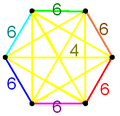| Omnitruncated 5-simplex honeycomb | |
|---|---|
| (No image) | |
| Type | Uniform honeycomb |
| Family | Omnitruncated simplectic honeycomb |
| Schläfli symbol | t012345{3[6]} |
| Coxeter–Dynkin diagram | |
| 5-face types | t01234{3,3,3,3} |
| 4-face types | t0123{3,3,3} {}×t012{3,3} {6}×{6} |
| Cell types | t012{3,3} {4,3} {}x{6} |
| Face types | {4} {6} |
| Vertex figure |  Irr. 5-simplex |
| Symmetry | ×12, [6[3[6]]] |
| Properties | vertex-transitive |
In five-dimensional Euclidean geometry, the omnitruncated 5-simplex honeycomb or omnitruncated hexateric honeycomb is a space-filling tessellation (or honeycomb). It is composed entirely of omnitruncated 5-simplex facets.
Contents
The facets of all omnitruncated simplectic honeycombs are called permutahedra and can be positioned in n+1 space with integral coordinates, permutations of the whole numbers (0,1,..,n).








